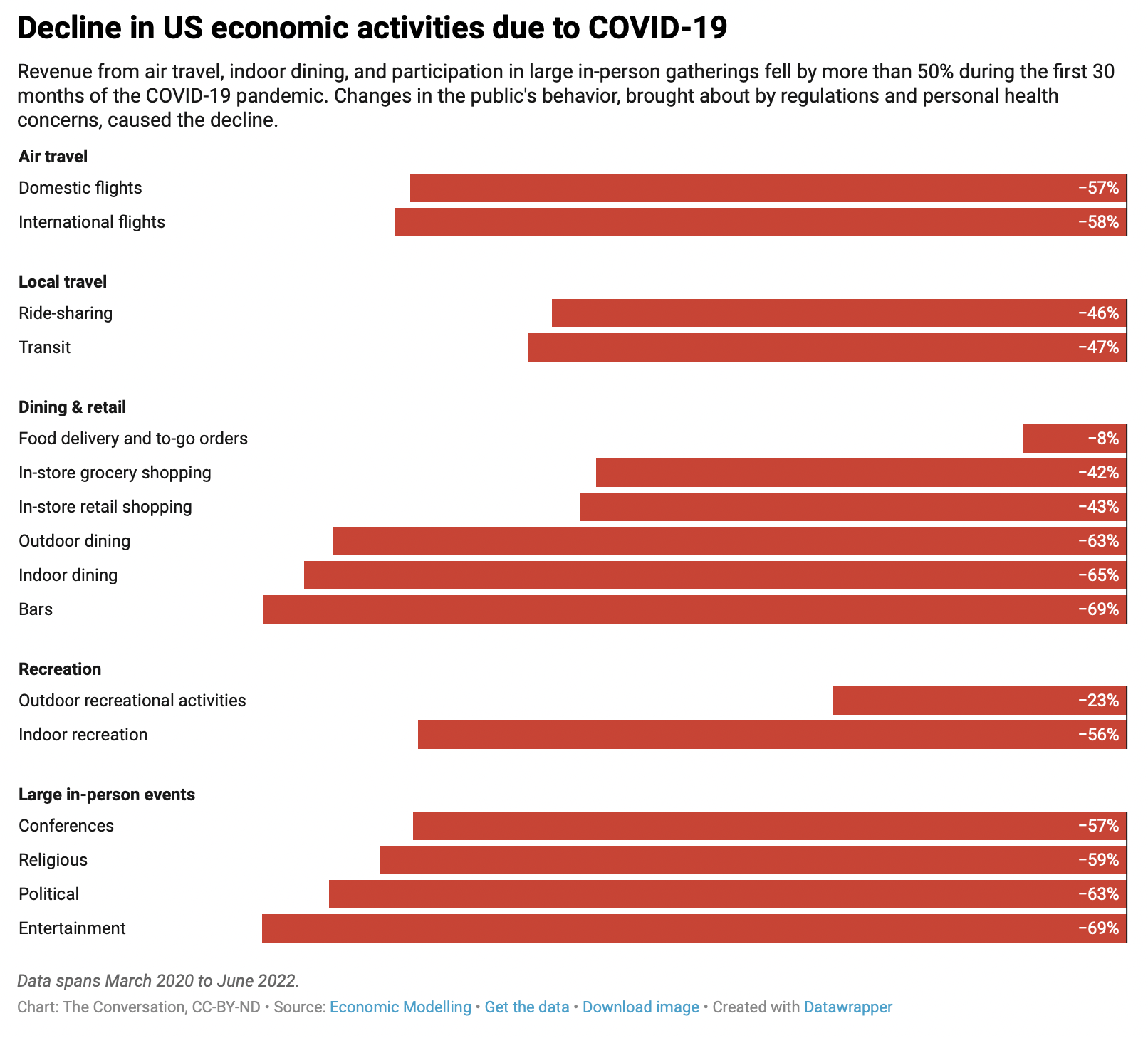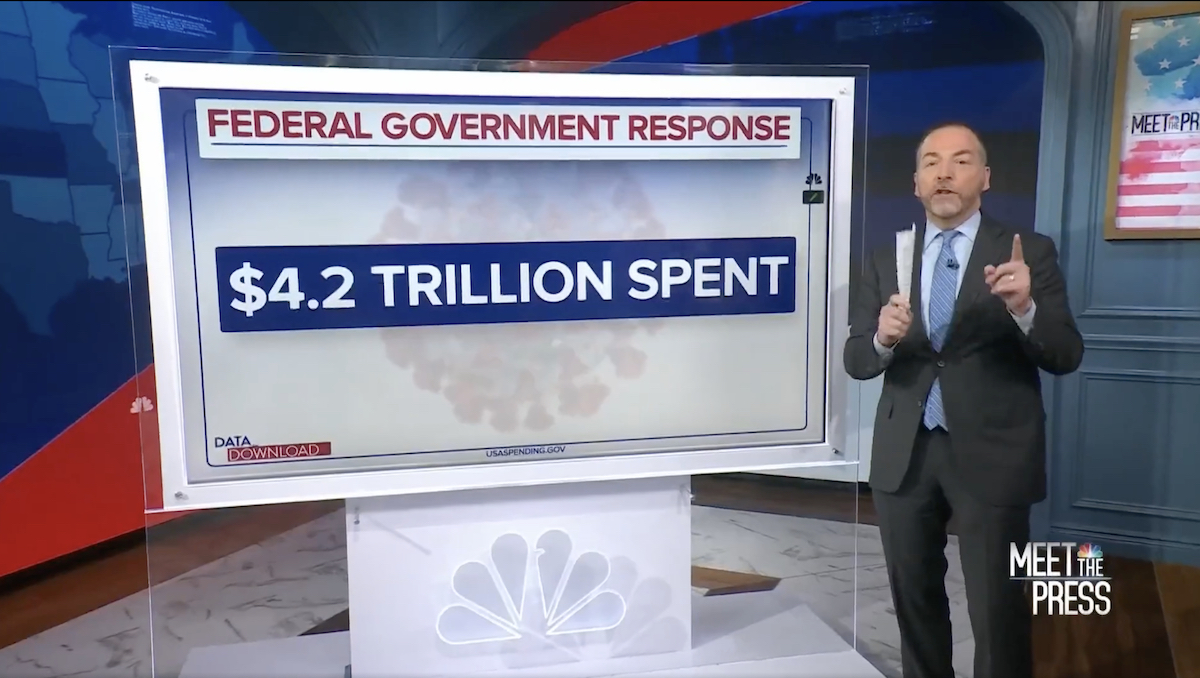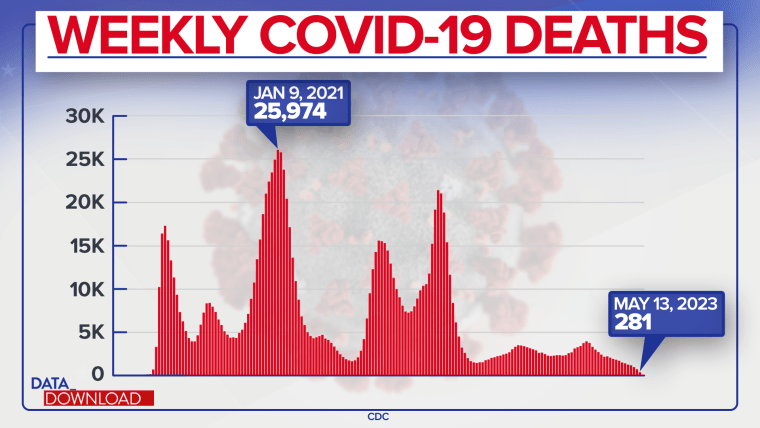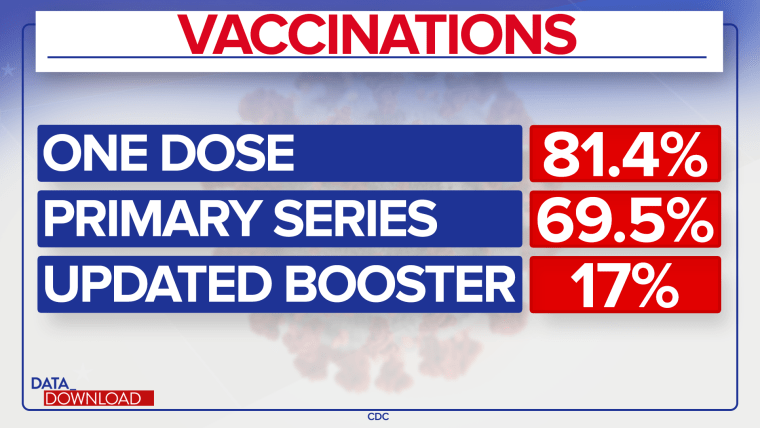Meet the Press
FOR EDUCATIONAL PURPOSES
As the Covid national emergency ends, what was its overall impact?
By the numbers …
-
More than 1.1 million Americans died. Only 281 died in the past week.
-
81% got at least 1 vaccine dose.
-
The U.S. economy is estimated to have a net loss of $14 trillion
The U.S. economy experienced a net loss of about $14 trillion in GDP, according to the USC Schaeffer Center for Health Policy and Economics. The group of economists and public policy researchers figured that number by calculating the U.S. GDP over the three-year period, about $103 trillion, and what it would have been with the pre-pandemic assumptions in place, $117 trillion.
Learn more:

WATCH: As the Covid national emergency ends, what was its overall impact?
By the numbers …
➡More than 1.1 million Americans died. Only 281 died in the past week.
➡81% got at least 1 vaccine dose.
➡The U.S. economy is estimated to have a net loss of $14 trillion. pic.twitter.com/PoDQ6SSG6Z— Meet the Press (@MeetThePress) May 21, 2023

NBC NEWS. The Covid emergency is over. Calculating the final toll is just beginning – 21 MAY 2023.
The state of emergency over the virus has ended, leaving staggering numbers of deaths and societal turmoil in its wake.
WASHINGTON — Earlier this month, the emergency that surrounded Covid-19 was officially declared to be over. The World Health Organization and the federal government both announced that Covid-19, or at least the worst part of it, was in the rearview mirror.
So this week, the Data Download turns its attention to the very real and very serious costs the virus inflicted upon the United States.
Let’s start with the most impactful toll: the loss of life that accompanied the three-year pandemic.

Since it first appeared in the United States in the March of 2020, Covid-19 took the lives of more than 1.1 million Americans, according to the Centers for Disease Control — a heavy loss. It’s more people than the population of Austin, Texas, Jacksonville, Florida or the state of Montana.
At its peak, in the days before there was a vaccine, Covid-19 took the lives of almost 26,000 Americans in just one week in January 2021. But the numbers are radically different today. The most current set of data puts the weekly death figure at less than 350.
Those numbers came down for a lot of reasons: People took precautions. People developed immunity. And, of course, the Covid-19 vaccines made a huge difference.

Despite complaints and anti-vax chatter, all told, more than 8 in 10 Americans received at least one dose of Covid vaccine. And about 70% of Americans received the two-dose primary series. Those are impressive numbers for a vaccine that became politicized.
Of course, the virus isn’t gone. There are still variants lingering in the larger population — and new variants are emerging, even if they are less lethal. A newer vaccine has been developed to deal with those challenges, but it has met with a less supportive public response. Only 17% of Americans have received the most recent booster.
Beyond the damage the pandemic did to Americans’ health, however, the biggest legacy may be its economic impact. The great national shut-down — people cancelling travel and get togethers, losing jobs or working from home, eating take-out and essentially upending their lives — rocked the economy. Some businesses scaled back, retrenched and laid workers off. Others closed permanently.
Rightfully, there was a lot of panic. People worried about whether they could pay their rent or mortgages or buy food. And the federal government rushed in to fill the need.

At the end of three years, the federal government spent more than $4.2 trillion to keep people afloat, according to USASpending.gov. That’s the amount of money spent through the CARES Act as well as other supplemental Covid legislation. It also includes money put forward in the later American Rescue Plan Act.
That money has been the subject of a lot of discussion. Some feel the federal government overspent to hold off a recession and, in the process, spurred inflation.
But whatever you think about it, that $4.2 trillion pales in comparison to the overall economic cost of the pandemic, according to USC’s Schaeffer Center for Health Policy and Economics.

When you add it all up, the U.S. economy experienced a net loss of about $14 trillion in GDP, according to the Center. A group of economists and public policy researchers figured that number by calculating the U.S. GDP over the three-year period, about $103 trillion, and what it would have been with the pre-pandemic assumptions in place, $117 trillion.
The biggest hits, the group says, were due to changes in human behavior that accompanied the pandemic — less air travel, fewer rides in taxis and buses, less eating out, and fewer live events. And the nation is still trying to figure out what the post-pandemic world will look like. How permanent will those changes in behavior be? Movie theaters, for instance, are just now starting to get their economic legs under themselves again. Their future is far from clear.
People can have short memories. And with the pandemic now officially behind us, many have moved on. Those first scary days and weeks and months feel like ancient history to a big chunk of the general population as they go to concerts and restaurants and fill airports again.
But the numbers make clear just how disruptive the virus was. In terms of lives lost and lives changed, the Covid-19 pandemic upended America. And even if the “emergency” around it is over, its impacts are still with us and may be felt for years.

